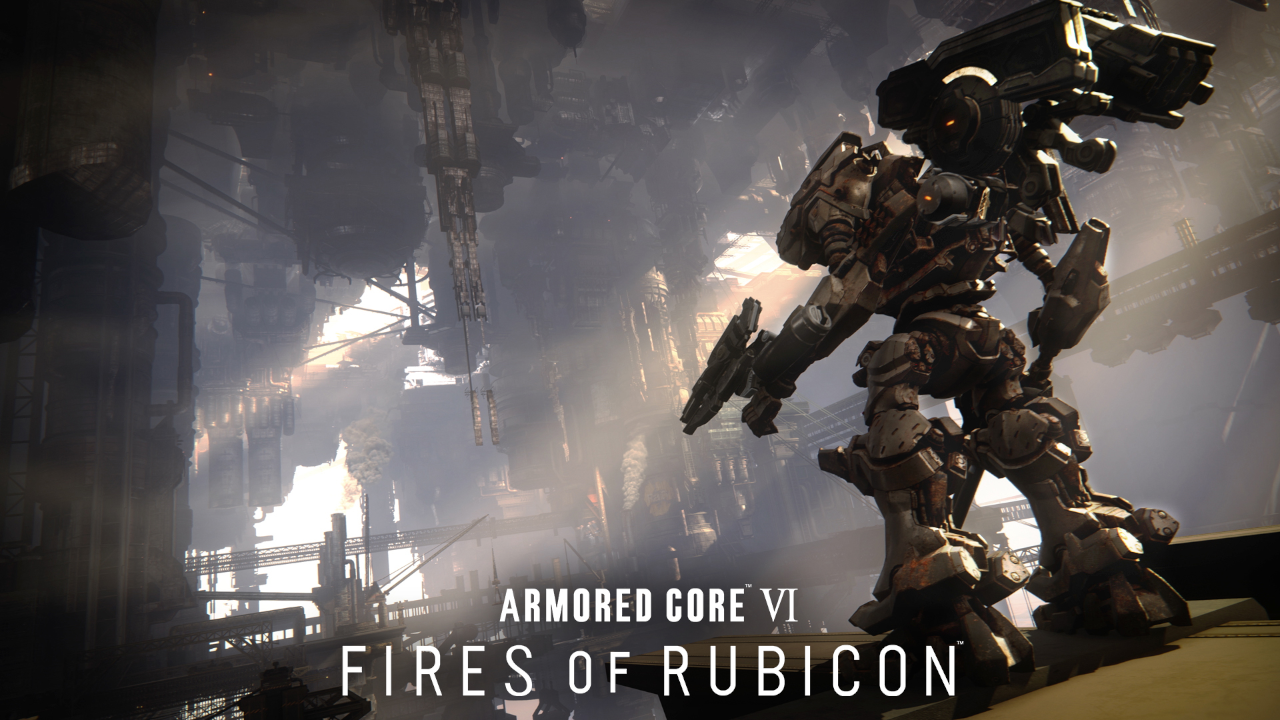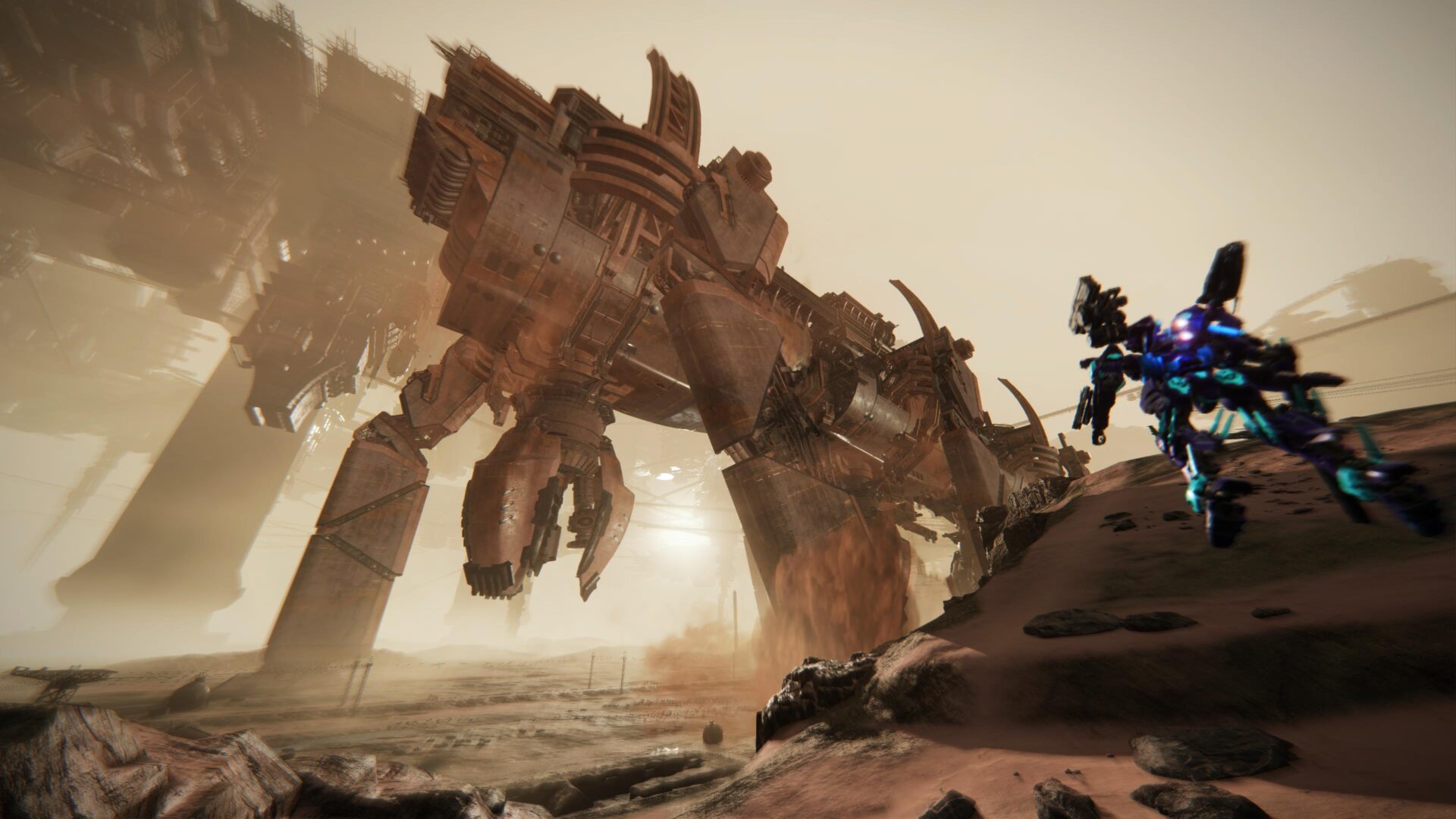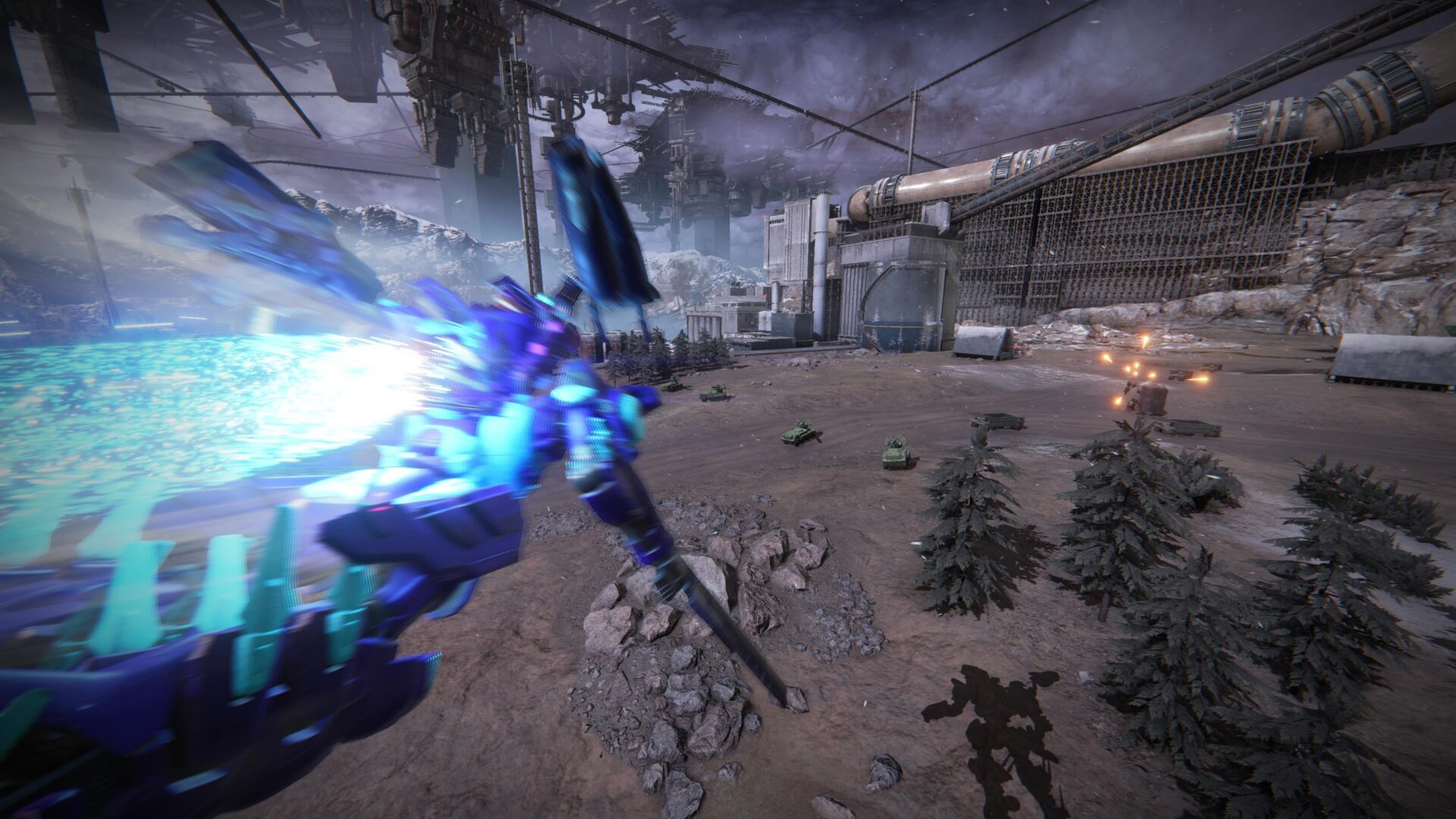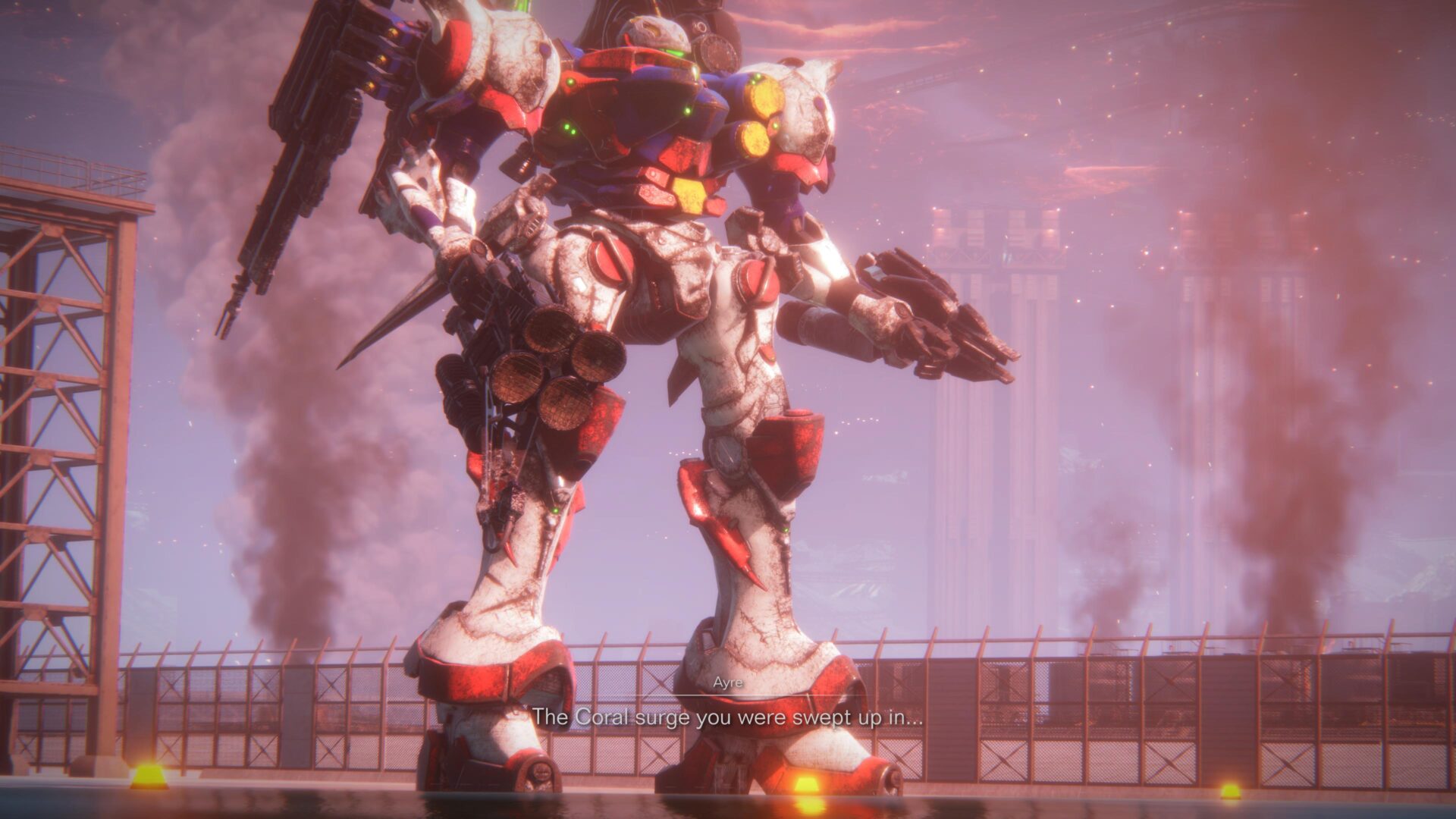
Last year was packed with long-awaited sequels, and From Software had their turn in the summer with Armored Core 6: Fires of Rubicon. Satisfying both long-term fans and newcomers attracted by the From Software pedigree seems like an unenviable mission. Fires of Rubicon largely delivers, though, and while it may not be the game’s core competency, there’s even some moral food for thought underneath all the tarnished metal plating.
In Armored Core 6: Fires of Rubicon, you assume the role of a pilot-for-hire genetically engineered to operate Armored Cores (ACs), the massive mechanical weapons from which the series takes its name. Dispatches and briefings from benefactors representing different corporations and political entities unfold AC6’s story, which thrusts you into the center of a brewing war on the planet Rubicon over a substance called Coral. Coral is sought by your clients for its ability to power revolutionary technological marvels, and also responsible for a planet-wide conflagration that turned Rubicon into a wasteland several decades before the events of the game. As such, finding and extracting Coral carries considerable risk – a risk your benefactors pay you to bear.

Uncovering the mysteries behind Coral and the goals of the various factions raging over Rubicon propels you through Fires of Rubicon’s campaign. Comprehending the conflicting motivations of all the groups seeking your services is at first a lot to take in, but the initial discomfort helps sell the story. You begin as simply an expendable tool in your handler’s arsenal, and If you wish to progress your interests can be only mercenary. It’s decidedly off-putting, and it should be. Over time, though, you come to connect the faceless voices to their associated companies, understand their goals, and are given choices of whom to support.
Aside from the campaign missions, you can test your mettle in 1v1 arena battles against CPU opponents modeled after characters referenced in the campaign. Completing these missions earns you points to spend in your AC’s equivalent of a talent tree. The choices range from simple (but valuable) passive improvements to various weapon types, new maneuvers like the Assault Kick or exploding shields, or the ability to use two main hand weapons on a single arm. In addition to these bonuses, the arena missions provide a little bit of context on the characters you encounter in the story. You’re also able to easily replay any completed mission, keep any credits earned, and aim for the highest rank possible. An online multiplayer mode is also unlocked as part of the campaign, though I must admit I did not engage much with this system.
In terms of its narrative, it is impressive how much AC6 achieves with so little. Sure, for a From Software game, Fires of Rubicon is a veritable font of exposition. However, you never once see another character’s face, and yet somehow you still forge impactful connections. By the end, those connections are tested as you’re forced to choose where you stand amidst shifting allegiances on the battlefield.
And what a battlefield it is. Armored Core 6 sports well-oiled combat mechanics that make you feel like an ace mech pilot once you get through the learning curve. There’s much to keep track of – between your AC’s right and left arms and shoulders, you’ll have four different weapons (or a shield), each of which has its own ammunition reserve, unique reloading/overheat characteristics, and optimum ranges. These armaments come in the form of standard projectile weapons like pistols or rifles, missile and rocket launchers, as well as plasma or laser weapons. (Naturally, civilized pilots prefer swords.) Your enemies all have the same – so while you’re managing all your own weapons, you’re also dodging incoming fire through the use of visual cues, and perhaps more importantly, audio cues.

For fans giving Armored Core a try after having enjoyed From Software’s more recent and more popular series, the focus on three-dimensional mobility is perhaps the biggest departure from the familiar, but it’s also part of what makes Armored Core 6’s combat so entertaining. It is probably the case that the combat is easier than you might expect, but I think a lot of that actually stems from the fact that AC6 is far more respectful of your time than Dark Souls or Bloodborne. Boss fights still pose a challenge, particularly in the late game, but they’re always immediately preceded by a checkpoint and a restoration of your ammo and armor. What’s more, if you do lose, you’re allowed to switch up your build and return to that checkpoint. You’re not permitted to buy new parts mid-mission, but that’s the only limitation.
At first, I chafed against that system a bit, hesitating to make dramatic changes to my build under the mistaken assumption that any design would be viable for a given encounter. Perhaps for more advanced players, they would be, but when I engaged more with the core systems and optimized for the particular missions or boss fights, I felt like the game was firing on all cylinders.
The other major element is the AC customization, which is quite a treat. I’ve only dabbled in the series, having played Armored Core 2 in my youth and Armored Core 4 over fifteen years ago, so my memories are not reliable enough to compare the mech-building here to other entries. However, on its own merits, choosing parts to outfit your AC is a satisfying process of choosing between competing goods with meaningful tradeoffs. Even in the late-game, there aren’t really parts that outright replace what you already have. Instead, your choices center on how you want to specialize, and what you’re willing to give up in one area to gain strength elsewhere. Generally speaking, greater firepower means a heavier overall build, which has a direct impact on your mobility.
You are somewhat limited to four AC styles dictated by your choice of legs. There’s standard bipedal legs for a well-rounded build, tank treads for carrying the heaviest of weapons, quad legs that let you hover, and reverse joint legs that excel at jumps. Within those categories, though, there’s plenty of choices so you can optimize for your given playstyle. Customization doesn’t stop at the numbers, though – there’s a paint booth that allows you to choose colors, textures, and shines down to the individual part. Furthermore, you can add preset (and even custom) decals if you so desire.

Customized or not, the mechs in Fires of Rubicon look great whether in the garage or in combat. Some of that comes from AC6’s technical polish, but there’s also inventive art direction in the designs of the different cores. No matter what, they’re animated in a way that simultaneously sells the heft of the enormous machines you’re flying and the idea that they could be whipped around as ridiculously fast as they must be.
The environments are all well-done, but there is definitely a “same-y” quality that probably can’t be avoided when the planet is an industrial wasteland. Deliberately distinct color palettes for different regions mitigate that somewhat, but also lead to an ever-present washed-out look that might be a turnoff to some. The UI designers deserve a bit of credit, too, as they’ve come up with a HUD that communicates all the information you need through a svelte set of bars that match the feel of the game and do not distract from the action.
On the musical front, Fires of Rubicon’s soundtrack is heavy on electronics and light on melody, as befits the nature and mood of the story. It is at its most mellifluous when it’s evoking Vangelis’s Blade Runner score, but aside from those moments there’s not much you’d want to listen to outside of the context of the game. That’s not really a knock against Armored Core 6, I just dig a good video game score I can listen to while working. I’m essentially complaining that there’s not frosting on my chocolate chip cookie.
Overall, I found Fires of Rubicon to be a satisfying experience and a welcome return for a series that had been dormant for so long. The story was more engaging than I expected, puzzling out AC builds was rewarding, and there were the kind of spectacular boss fights From Software’s known for. To the extent that I have criticisms, it may just be that I’d have preferred to be allowed to simply replay decision points rather than be required to repeat the entire campaign to see how different choices play out. I was perfectly satisfied with the decisions I made in my first campaign run, and did not feel sufficiently incentivized to complete the campaign one or two more times.
Spiritual Value
Behind the giant robot combat, the state of Fires of Rubicon’s world illustrates themes that are somewhat consonant with the gospel. AC6 depicts a grim future, devoid of any sense of the divine, where powerful individuals and factions treat those less powerful, at best, as nothing more than tools. I wouldn’t claim that juxtaposition is intentional, but it remains a rendering of the violence that can be wrought when we abandon the transcendent and turn inward. The words of the unrighteous men of Wisdom 2, “…let our might be our law of right, for what is weak proves itself to be useless,” could very well be on the lips of most of the factions warring over Rubicon. Furthermore, the discomfort that stems from the player’s initial ignorance of what might be good or right demonstrates our innate sense that those moral truths exist outside ourselves.
Fires of Rubicon also drives home the power of names, as the manner in which your clients address you is a major point of differentiation. To some you’ll always be a dog on a leash, while for others you’re a respected pilot or even a lifeline. Which names you want to live up to will influence the choices you make. Consequently, on a personal level, Fires of Rubicon can make us more mindful of how we address others. I was reminded particularly of the influence my words can have for my children, and how I must always strive to be encouraging and edifying, which is a standard I fall short of all too often.
More broadly, recognizing the power of names can remind us that it is Christ to whom we should look for the name we wish to live up to in this life. As Christ promises in Revelation, “To him who conquers…I will give him a white stone, with a new name written on the stone which no one knows except him who receives it.” He has called us by name, and we are His, even if we’re flying huge mechs while humming a tune from Gundam Wing.

Scoring: 83%
Gameplay: 4.5 / 5
Story: 4 / 5
Aesthetics: 4 / 5
Morality/Parental Warnings
Violence: the violence on offer here is between machines of varying descriptions. Lots of explosions, but nothing gory.
Suggestive Content: with a focus on machine combat and no actual humans shown, there’s not much to report. There’s a mention of an intimate relationship between two men in the text preceding one of the arena battles.
Language: there’s some cursing, but nothing that stood out to me. There is reference to drug-taking/abuse, but like anything else, it’s not directly depicted since there’s no human bodies in the game.
